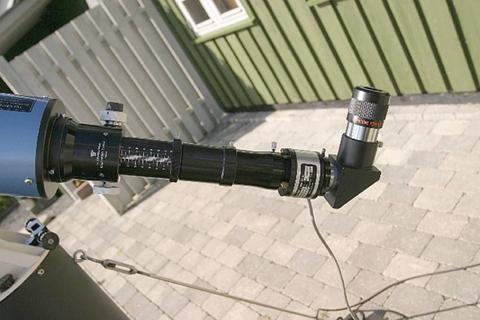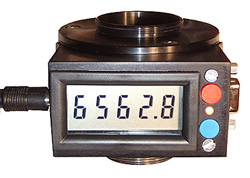DayStar Filters have been in operation for over 30 years. If you have a problem, chances are, it has been encountered and resolved by others before you. This section is for helping you find solutions to everyday issues you might encounter. Most customer service questions about DayStar can be solved without returning the filter to the factory. Please read your troubleshooting section carefully. If it is unclear or does not address your problem, please contact us at: info@daystarfilters.com.
Focus Questions:
Common Issue: Cannot achieve focus. Telescope using barlow needs more backfocus than telescope will provide.
Solution: Relocate Powermate and DayStar behind the diagonal.
Solution: Some clients apply a focal reducer to the rear of a DayStar. This shortens focus and reduces the image size.

More information on why:
Focus can be a concern for DayStar ATM and T-Scanner users who are using a barlow or powermate to reach F/30. It is important to understand the first rule of a negative lens (barlow). Its job is to increase focal length. While a 4X Powermate changes a 800mm FL telescope to a 3200mm FL telescope, one cannot rack the focuser out an additional 8 feet back. It doesn’t quite work that way.
So how does it work?
The position where the telescope comes to focus is called the “OBJECT”. This is our starting point from which everything begins. The farther forward from this original OBJECT the barlow is introduced, the farther back it moves the object…. multiplied by a factor of the barlow’s power! Here is an example:
- A 2X barlow is added 1″ in front of the object. It changes 1″ into a 2″. That takes 1″ to get back to the original object and adds an additional 1″ in backfocus.
- A 4X barlow is added 1″ in front of the object. This acts the same, but after 1″ to get back to the original object, an extra 3″ is needed in backfocus now.
- A 4X barlow is added 3″ in front of the object. The distance is multiplied by 3. 3″ becomes 12″. So 9″ in additional backfocus is now needed.

A diagonal can occupy 3-5 inches of backfocus so move the powermate and DayStar behind the diagonal to reduce the needed backfocus.
*A note about Mewlon 250’s and Newtonians. DayStar has found that Mewlon 250 owners in general have difficulties reaching focus. There exist adapter issues and focus issues, with the location of the telescope’s object in relationship to the telescope’s focuser. Many Newtonian and Dobsonian telescope users are frustrated by this “inside the basket” focus frustration. As we see above, backfocus can be gained by introducing a barlow.
Heat / Housing Questions:
Common question: User cannot tell if old style ATM heater housing is working.
Test: Install the filter onto the telescope, then plug it in. Watch as it warms up (or doesn’t) to see if the image changes.
- If the image changes, then the heat functions.
- If the dongle on the cord gets hot, the housing may or may not be working.
- DayStar heaters have used dial settings of 6-8 through the decades. Test with a low setting of 6, then slowly dial up to 7, then 8 on the dial. It works like a clock with a big and little hand. Do not dial past 8. If no change is noted, then the heat is not likely working.
- If the old ATM heater has been used on a 12V inverter it may be broken.
- If the old ATM was dialed above setting 8, it may be broken.

Answer: If the above tests indicate that the heat isn’t working, the housing may be repaired or upgraded to a new Quantum housing. A repair cost is $350. An upgrade cost is $700. An upgraded Quantum will not break when used on 12V power or break by incorrect dial operation.
Common problem: The heat is working, but it doesn’t appear to be quite on-band.
Solution: For ATM and University models, the knob pot on the power cord can be dialed carefully to hotter and cooler settings. The higher the setting, the hotter the filter housing will operate. Dial the knob half of a revolution at a time, then wait for the temperature to slowly move and settle. 10 minutes is a good waiting time for heat to settle after a change going UP. It may need 15 minutes coming down. You may watch your filter’s center wavelength (CWL) change with this setting change. This will allow you to find the ideal position where both the leading and following edge of the sun show maximum detail at the same time.
Solution: For Quantum models, the red and blue buttons are designed for users to shift this position with control. It may also be used with the Quantum Control Software remotely via a serial cable. The Quantum display has 2 modes or views. CURRENT and TARGET. The current view shows what the filter is transmitting. It does not blink. The target view shows what wavelength it is attempting to reach.
If you wish to change your target wavelength,
- press either button – to change to blinking target mode.
- the display will blink the target wavelength.
- repeatedly press red(up) or blue(down) buttons until the blinking number changes.
- the target can be changed up to 1.0Å higher and lower than the programmed CWL.
- If it is too hot outside, a filter may not be able to cool enough to reach -1.0Å of programmed CWL.
- Explore .5Å hotter and colder. ie: press blue over and over until the blinking number reads 6562.3 or press the red button over and over until the blinking number reads 6563.3.
- Every time the target wavelength is changed, the quantum light will turn yellow. It will turn green again after the current reaches the target – and after it settles all through the glass.

Common question: The Quantum buttons do not respond.
Answer: Remember to push the buttons over and over. Do not press and hold the buttons. Do not press the button only once. One push will make it blink in target mode. After it blinks, push again to drive it up or down in wing.
Answer: The Quantum also has a button lockout feature. If the buttons do not make the LCD blink, then the lockout feature is engaged. Unplug the Quantum and hold down BOTH RED and BLUE buttons – while plugging the filter back in. This will disengage the lock-out. The lockout can also be set through the serial port using the Quantum Control Software.
Adapter Questions:
Common question: An adapter is required to mount filter to a new telescope configuration. What do adapter do I need?
Answer: If changing between an off-axis reflector and an on-axis refractor. a change is needed in the front (gold side) outer-most metal plate. It is designed to be changed by the end user and is safe to remove. 
- A reflector like an SCT needs a wedge plate to offset the angle light leaves the telescope and enters the DayStar.
- A refractor needs a flat plate because light is entering the DayStar strait on.
Please see the DayStar Adapter Plate page for further details on varieties and prices
Common question: SCT, 2″, 1.25″ fittings? What components can I use to match with my:
- 1.25″ drawtube? We offer a 1.25 female and male drawtube set.
- 2″ drawtube and eyepieces? A T-thread-2″ male drawtube is available for the gold side. An SCT-2″ female drawtube is available for the Red rear side.
- SCT rings? A t-thread to SCT adapter will work between a common SCT plate and the 2″ x 24″ back threads of an SCT. The DayStar comes with a 2″ x 24″ rear male plate on which you can screw any ordinary SCT accessories such as focal reducers or visual backs.
Image Quality Questions:
Common question: Image is dim and darker than it used to be. There may also be a spot at the center of the field of view that is better than the rest.
Answer: Blockers and trimmers darken from the outside in. They usually last about 10 years before they start to age. They age faster in warm, humid areas. Coastal communities and tropical environments are known to cause faster aging and darkening. When this happens, the filter must come back to the lab for us to replace these elements. If the filter is out of warranty, then the repair is covered. If not, the cost is $750 and is backed by a new 10 year warranty.
Common question: The sun shows no prominences or activity.
Answer: First be sure there are prominences and activity ON the sun that day. Check the DayStar website for the most current daily image of the sun in H-alpha. This image is taken in ideal seeing conditions at altitude. While your view should not always look just like this image, if there are no proms or active regions to see in the daily image, then you will not likely have any prominences to look at in your filter either. Remember that we are at solar minimum right now (2008) so in no time, we will begin seeing a lot more.
Answer: It is also possible your filter is off-band. A filter not tuned to H-alpha will not show prominences or surface detail. This could happen because you need to tilt the T-scanner or SolaREDI’s tuning adjustment; because your filter is not plugged in, or heat broken… or because your t-scanner or SolaREDi is outside of its operating range.
The T-scanner and SolaREDi have a “fiddle factor” which means the user must dial around to find his own on-band position of tilt. The T-scanner has a knob to tilt. The SolaREDi twists the front, black dew shield itself. It is always best to twist the adjustment, like focus, beyond the best view and back again. If you have a Quantum and it is off-band, see the heat troubleshooting section.
For further details on the ideal application and configuration of your telescope for H-alpha viewing and imaging, please check our performance page.
For more information contact: service@daystarfilters.com

